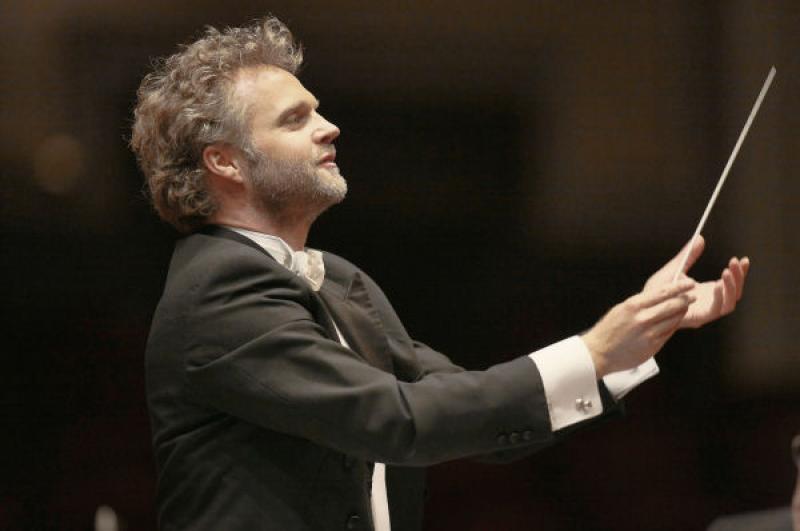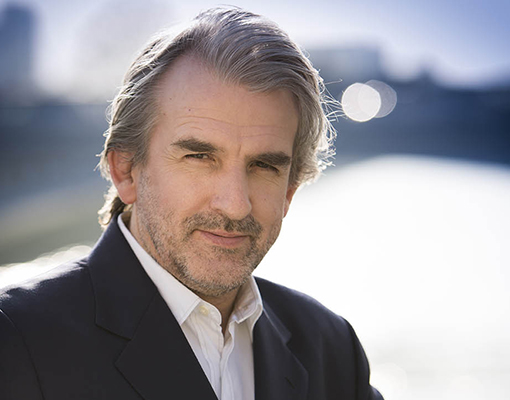Douglas, LSO, Søndergård, Barbican | reviews, news & interviews
Douglas, LSO, Søndergård, Barbican
Douglas, LSO, Søndergård, Barbican
Russian classics energised by clean lines and precise textures

Thomas Søndergård stood in for this concert at a day’s notice – Valery Gergiev is apparently recovering from a knee operation and unable to travel. He left behind a curious programme, centred around Prokofiev’s quirky but dour Sixth Symphony. It’s a difficult work to schedule, but Gergiev added two sweeteners, Tchaikovsky’s Romeo and Juliet and First Piano Concerto.
Dynamism and focus are the key qualities of Søndergård’s interpretations. His tempos are generally fast, although he doesn’t shy away from rubato, and clarity of texture always takes precedence over dynamic extremes. That can sometimes be frustrating, especially in slow, quiet passages that are never allowed to relax, and in blazing, brass-capped codas that can feel underplayed. But the result is a valuable sense of coherency and a refined tonal palette, based on the impressive playing that Søndergård draws from every member of the orchestra.
There was just enough passion in the love theme, although no sense of abandon
Such details were apparent from the very opening of Romeo and Juliet, the rich sound of the mid-range woodwinds here setting the tone beautifully. Søndergård’s fleet tempos and dynamic restraint gave the music a directed, narrative quality. There was just enough passion in the love theme, although no sense of abandon. The only disappointment was the coda: the dynamics in the funereal music were too high and there was no sense of stillness, and the final climax, again even and steady, underwhelmed.
Barry Douglas (pictured below left by Eugene Langan) has a long association with the Tchaikovsky First Piano Concerto, going back to 1986 when he won the gold medal at the Tchaikovsky Competition with his rendition. Thirty years later, he is not complacent, and his reading this evening, while technically accomplished, was fresh and vibrant. Douglas has a definite but light touch, every chord cleanly articulated, but with plenty of nuance too, a blessing given Tchaikovsky’s often congested chord voicing. Søndergård is the ideal partner for Douglas’s Tchaikovsky, and the dynamism and detail the conductor drew from the orchestra perfectly complemented the pianist’s phrasing and tone. The slow movement was the highlight, particularly for the precise ensemble of the string pizzicatos and the lyrical beauty of the flute solo, perfectly carried over into the piano.
 Despite his late booking, Søndergård clearly has an intimate knowledge of Prokofiev’s Sixth Symphony, which he here delivered in an idiomatic but highly convincing reading. Listening to the mid-range woodwinds in the opening – their textures as clear as ever – the connections in Gergiev’s mind with Romeo and Juliet became clear. As in the Tchaikovsky, Søndergård sacrificed some atmosphere for the sake of flow and clarity. The result was a constructive tension between conductor and composer, with Prokofiev’s extremes of texture and dynamic continually reined in. But the focus on clarity and balance only served to heighten the sombre mood of the opening, and however much reserve Søndergård imposed, the fireworks that followed from the woodwind and brass had an electrifying effect. So too in the second movement, here taken a notch or two above the designated Largo, but with Prokofiev’s stark dissonances raising the tension in spite of the conductor’s reserve.
Despite his late booking, Søndergård clearly has an intimate knowledge of Prokofiev’s Sixth Symphony, which he here delivered in an idiomatic but highly convincing reading. Listening to the mid-range woodwinds in the opening – their textures as clear as ever – the connections in Gergiev’s mind with Romeo and Juliet became clear. As in the Tchaikovsky, Søndergård sacrificed some atmosphere for the sake of flow and clarity. The result was a constructive tension between conductor and composer, with Prokofiev’s extremes of texture and dynamic continually reined in. But the focus on clarity and balance only served to heighten the sombre mood of the opening, and however much reserve Søndergård imposed, the fireworks that followed from the woodwind and brass had an electrifying effect. So too in the second movement, here taken a notch or two above the designated Largo, but with Prokofiev’s stark dissonances raising the tension in spite of the conductor’s reserve.
No such conflict, though, in the finale, the conductor’s approach here in perfect accord with the music’s vibrant, neoclassical profile. The orchestra, too, shone, particularly the brass soloists and the large but well-disciplined percussion section. Søndergård’s thorough knowledge of the work was a particular asset in the coda, with its erratic tempo changes and unpredictable outbursts. As ever, the conductor’s sense of control and proportion were evident, but the solid orchestral tone, combined with the focused drive directed squarely at the ending, brought an unforced logic to these final pages, the full intensity of Prokofiev’s symphonic statement now heard without a trace of restraint.
rating
Share this article
The future of Arts Journalism
You can stop theartsdesk.com closing!
We urgently need financing to survive. Our fundraising drive has thus far raised £49,000 but we need to reach £100,000 or we will be forced to close. Please contribute here: https://gofund.me/c3f6033d
And if you can forward this information to anyone who might assist, we’d be grateful.

Subscribe to theartsdesk.com
Thank you for continuing to read our work on theartsdesk.com. For unlimited access to every article in its entirety, including our archive of more than 15,000 pieces, we're asking for £5 per month or £40 per year. We feel it's a very good deal, and hope you do too.
To take a subscription now simply click here.
And if you're looking for that extra gift for a friend or family member, why not treat them to a theartsdesk.com gift subscription?
more Classical music
 Bizet in 150th anniversary year: rich and rare French offerings from Palazzetto Bru Zane
Specialists in French romantic music unveil a treasure trove both live and on disc
Bizet in 150th anniversary year: rich and rare French offerings from Palazzetto Bru Zane
Specialists in French romantic music unveil a treasure trove both live and on disc
 Scottish Chamber Orchestra, Ibragimova, Queen’s Hall, Edinburgh review - rarities, novelties and drumrolls
A pity the SCO didn't pick a better showcase for a shining guest artist
Scottish Chamber Orchestra, Ibragimova, Queen’s Hall, Edinburgh review - rarities, novelties and drumrolls
A pity the SCO didn't pick a better showcase for a shining guest artist
 Kilsby, Parkes, Sinfonia of London, Wilson, Barbican review - string things zing and sing in expert hands
British masterpieces for strings plus other-worldly tenor and horn - and a muscular rarity
Kilsby, Parkes, Sinfonia of London, Wilson, Barbican review - string things zing and sing in expert hands
British masterpieces for strings plus other-worldly tenor and horn - and a muscular rarity
 From Historical to Hip-Hop, Classically Black Music Festival, Kings Place review - a cluster of impressive stars for the future
From quasi-Mozartian elegance to the gritty humour of a kitchen inspection
From Historical to Hip-Hop, Classically Black Music Festival, Kings Place review - a cluster of impressive stars for the future
From quasi-Mozartian elegance to the gritty humour of a kitchen inspection
 Shibe, LSO, Adès, Barbican review - gaudy and glorious new music alongside serene Sibelius
Adès’s passion makes persuasive case for the music he loves, both new and old
Shibe, LSO, Adès, Barbican review - gaudy and glorious new music alongside serene Sibelius
Adès’s passion makes persuasive case for the music he loves, both new and old
 Anja Mittermüller, Richard Fu, Wigmore Hall review - a glorious hall debut
The Austrian mezzo shines - at the age of 22
Anja Mittermüller, Richard Fu, Wigmore Hall review - a glorious hall debut
The Austrian mezzo shines - at the age of 22
 First Person: clarinettist Oliver Pashley on the new horizons of The Hermes Experiment's latest album
Compositions by members of this unusual quartet feature for the first time
First Person: clarinettist Oliver Pashley on the new horizons of The Hermes Experiment's latest album
Compositions by members of this unusual quartet feature for the first time
 Gesualdo Passione, Les Arts Florissants, Amala Dior Company, Barbican review - inspired collaboration excavates the music's humanity
At times it was like watching an anarchic religious procession
Gesualdo Passione, Les Arts Florissants, Amala Dior Company, Barbican review - inspired collaboration excavates the music's humanity
At times it was like watching an anarchic religious procession
 Classical CDs: Camels, concrete and cabaret
An influential American composer's 90th birthday box, plus British piano concertos and a father-and-son duo
Classical CDs: Camels, concrete and cabaret
An influential American composer's 90th birthday box, plus British piano concertos and a father-and-son duo
 Cockerham, Manchester Camerata, Sheen, Martin Harris Centre, Manchester review - re-enacting the dawn of modernism
Two UK premieres added to three miniatures from a seminal event of January 1914
Cockerham, Manchester Camerata, Sheen, Martin Harris Centre, Manchester review - re-enacting the dawn of modernism
Two UK premieres added to three miniatures from a seminal event of January 1914
 Kempf, Brno Philharmonic, Davies, Bridgewater Hall, Manchester review - European tradition meets American jazz
Bouncing Czechs enjoy their Gershwin and Brubeck alongside Janáček and Dvořák
Kempf, Brno Philharmonic, Davies, Bridgewater Hall, Manchester review - European tradition meets American jazz
Bouncing Czechs enjoy their Gershwin and Brubeck alongside Janáček and Dvořák
 Solomon, OAE, Butt, QEH review - daft Biblical whitewashing with great choruses
Even a top soprano and mezzo can’t make this Handel paean wholly convincing
Solomon, OAE, Butt, QEH review - daft Biblical whitewashing with great choruses
Even a top soprano and mezzo can’t make this Handel paean wholly convincing

Add comment